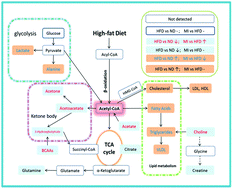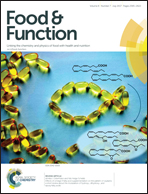A 1H-NMR based metabolomics study of the intervention effect of mangiferin on hyperlipidemia hamsters induced by a high-fat diet†
Abstract
It has been demonstrated that mangiferin can ameliorate hypertriglyceridemia by modulating the expression levels of genes involved in lipid metabolism in animal experiments, but its effects on the serum metabolic fingerprinting of hyperlipidemia animal models have not been reported. Thus, a NMR-based metabolomics approach was conducted to explore the effects of mangiferin on hyperlipidemia hamsters and to gain a better understanding of the involved metabolic pathways. Hamsters fed with a high-fat diet were orally administered with mangiferin 150 mg per kg BW once a day for 8 weeks. Serum samples were analysed by 1H NMR, and multivariate statistical analysis was applied to the data to identify potential biomarkers. In total, 20 discriminating metabolites were identified. It turned out that mangiferin administration can partly reverse the metabolism disorders induced by a high-fat diet and exerted a good anti-hypertriglyceridemia effect. Mangiferin ameliorated hyperlipidemia by intervening in some major metabolic pathways, involving glycolysis, the TCA cycle, synthesis of ketone bodies, and BCAAs as well as choline and lipid metabolism. These findings provided new essential information on the effects of mangiferin and demonstrated the great potential of this nutrimetabolomics approach.



 Please wait while we load your content...
Please wait while we load your content...